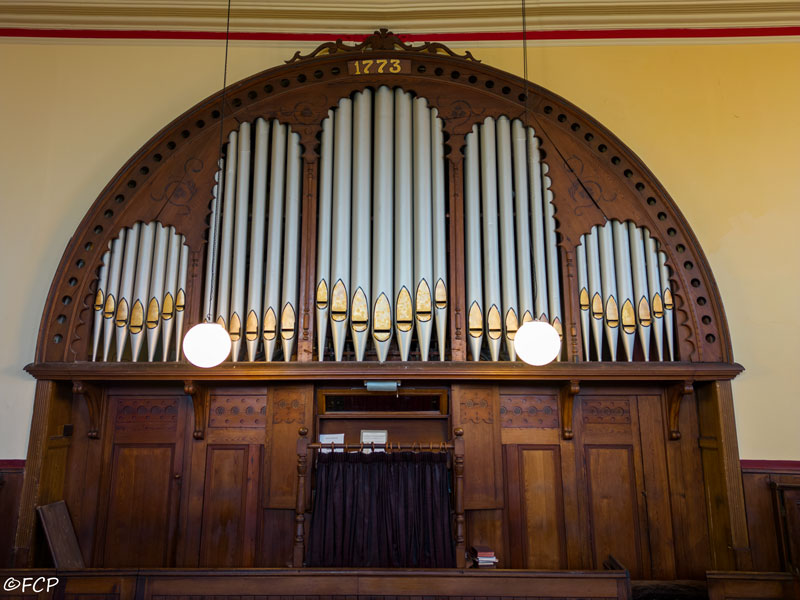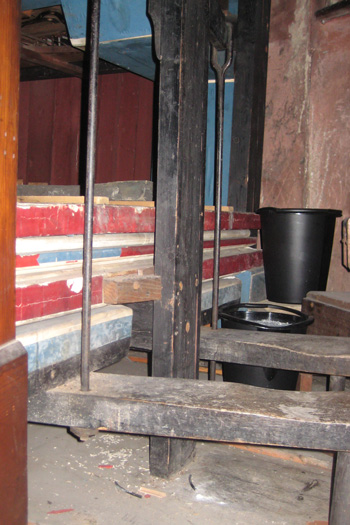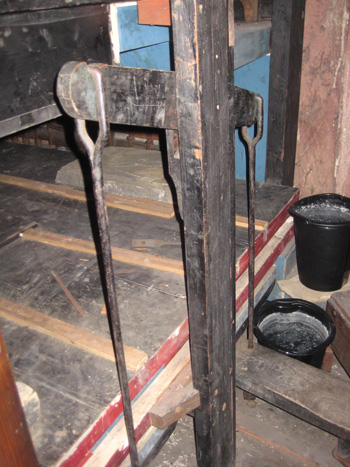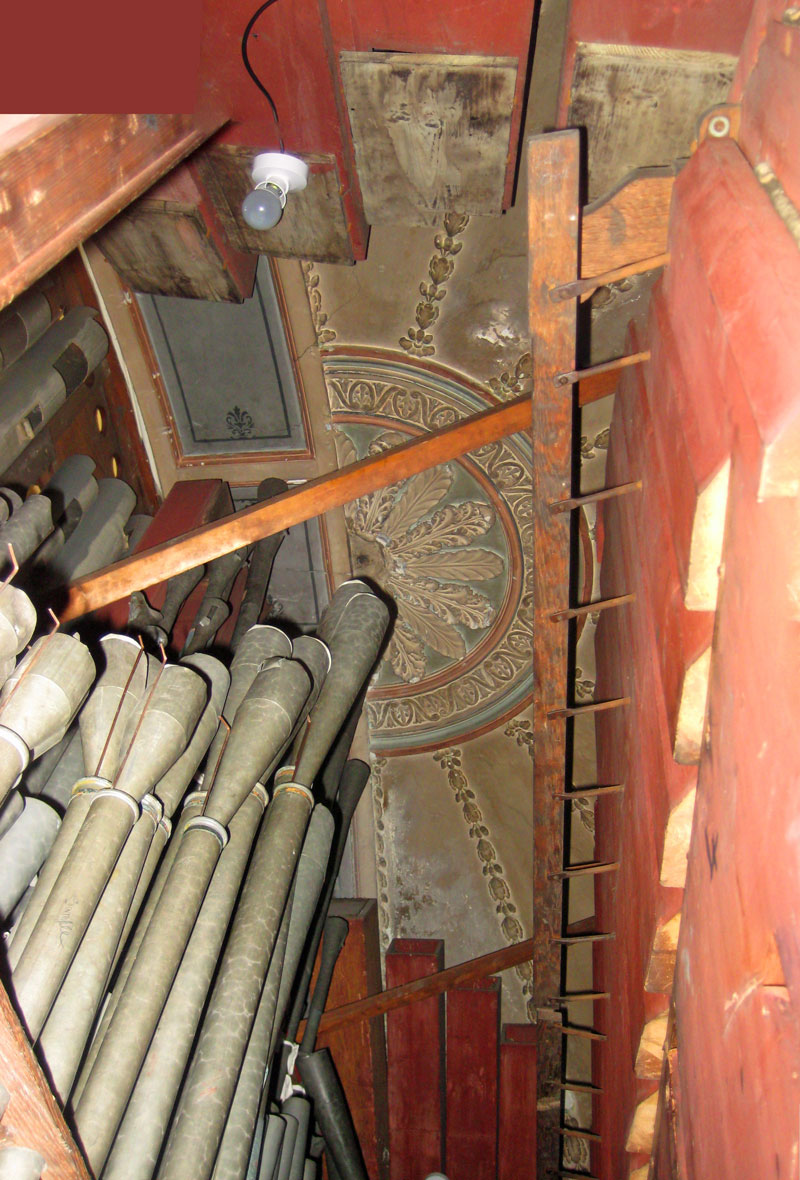The Mount Zion Organ

Mount Zion Anneessens Organ
Irene Cunliffe gathered together the following information about the organ:
It is recorded in
a cash book dating from 1881 that on the 25th July, 1891, Anneessens were
paid £350 for a new organ and it cost £1.14s.0d.
to convey it. The conveying was done by C. E. Coton (a firm which still
exists).
On the 7th June,
1894, it is recorded Anneessens & Sons were paid £2.0s.7d.
for tuning.
Specification:
GREAT ORGAN: 56 NOTES – large
open diapason, 8ft., 86 pipes; harmonic flute, 8ft., 56 pipes; dulciana,
8ft. 56 pipes; principal, 4ft., 56 pipes: clarionette, 8ft., 44 pipes: flute,
4ft., 56 pipes; ocarina, 4ft., 56 pipes; fifteenth, 2ft., 56 pipes;
SWELL ORGAN: 56
NOTES – Bourdon,
16ft., 56 pipes; liablichgedacht, 8ft., 56 pipes; open diapason, 8ft., 56
pipes; gamba, 8ft., 56 pipes; voix celeate, 8ft., 44 pipes; flute, 4ft.,
56 pipes; flageolette, 2ft., 56 pipes; horn, 8ft., 56 pipes; oboe, 8ft.,
56 pipes; tremulant.
PEDAL ORGAN: 30 NOTES – Large
open diapason, 16ft., 30 pipes; small open diapason, 8ft., 30 pipes.
COUPLERS: Great to pedal, swell to pedal, swell to great. Two
composition pedals to swell
In the Halifax Guardian on the 8th August, 1891 there was an entry:
The erection of
a new organ at Mount Zion Chapel, Ovenden, is now completed, the workmen
of Messrs. Anneessens & Sons of Belgium, the builders, tested
the instrument yesterday. Only the painting and varnishing remains
to be done. The organ is to be opened this Saturday evening when a recital
is to be given by Mr. G. S. Melville, F.C.O., of Keighley.
Organ opening at
Mount Zion Chapel – on Saturday evening the new organ
which has been erected at Mount Zion Chapel, was formally opened and a recital
was given on the instrument by Mr. G. S. Melville, F.C.O., Keighley. This
organ has been built by Messrs. Charles Anneessens and Son of Belgium and is
stated to be a very fine rich toned one.
There was a large attendance at the opening services on Saturday evening, the
attendance including many local organists. Mr. Melville of Keighley played.
In a commemorative
booklet which was published in 1973 for the bi-centenary of Mount Zion the
following appears:
The present organ
was built in 1892 (sic) by a Belgian firm, Charles Anneessens by name. It
has long been considered for its size, a most delightful instrument both
to play and hear.
Mr. John Anneessens, son of Charles who was responsible for its installation,
during World War I was a refugee at Lindley and visited Mount Zion to
look at the old instrument.
In the Halifax Courier in 1968, there appeared the following:
Father Charles Annessens
of Lendelade, Belgium, visited Mount Zion Methodist Church, Ogden, yesterday
to see and hear the organ which his grandfather built in 1891. With him was a friend Mon. Herman Roelstraete, a musician and
composer, who played the organ. Recordings were made.
The two men are
making a tour of the country and visiting various towns where similar organs
had been installed. They
had come to Mount Zion from Rochdale and were on their way to Bradford.
The family of Anneessens is still building organs they disclosed and Father Anneessen’s brother
is engaged in this work.
The newspapers were local ones. There was the Halifax Guardian
which was a weekly paper and then the Halifax Courier which was daily. They
eventually joined together and became the Halifax Courier and Guardian – hence
the apparent discrepancy in the above two items.
Mount Zion is locally
referred to in the following geographical areas of the Halifax Borough – Bradshaw
(within which Parish it rests), Ogden, Illingworth and Ovenden.
When the organ was
built they did not use the usual metal weights on the bellows, etc. but used
the local Yorkshire stone. The original organ blowing mechanism
can still be seen. It is behind the organ case and is operated by foot
pedals not a handle.
 
The original organ blowing mechanism behind the organ case
The organ has been
tuned and repaired and had an overhaul in the 1980s but it needs an enormous
amount of money spending on it. It is suggested £100K would put it right. If we had that
money I don’t think it should be spent on it for a couple of hours use
each week – although as historian I would probably disagree but can see
the morality behind what is being said.
As a result of refurbishing
the Chapel the organ was damaged due to overheating. The thermostat
did not work on the heating system, unbeknown to us for a while, and it dried
out the woodwork, etc. We had Mr. Malcolm Spink of Leeds recommended
to us from the Connexion and he came and spent some time on it. The
main problem was that the air was not being contained as it should due to
the leather bellows having lost their original size due to age and many minute
holes caused by vermin. As a result of Mr. Spink’s investigations
we have been able to put a booster on the blower and the organ is now playing
well.
We
were given £3,000 as a legacy from a Mr. John Bradley and, as his father
and grandfather had been organists at Mount Zion, we decided to spend the money
on the organ. Mr. Bradley’s widow died last year and she also left £3,000
so again we are putting it to the organ. Mr. Spink now tunes the organ
and each time he comes he spends the day at Mount Zion and does a bit more
work each time.
We are getting it
into better condition and to us it sounds good although visiting organists
say “it’s like driving
a tank”!
The organ is refurbished a little bit each year.
More details can be found on The National Pipe Organ Register index N107101
In 2010, the British Institute of Organ Studies awarded
a certificate Grade 11, in recognition of it being a fine example of an instrument
by Charles Annessens 1891, substantially in original condition.
Originally the pulpit was in the apse where organ is now. The dome shaped ceiling was richly decorated. The following photograph gives a glimpse of what it was like.

Behind the organ case and the decorative ceiling
In Christopher Stell's Nonconformist Chapels and Meeting Houses in the North of England, it makes reference to the apse being added in c.1840 to provide a vestry with singers' gallery above. The interior was refitted in c.1881 by Leeming and Leeming of Halifax. It continues, 'There is a gallery around three sides with angled corners. The singers' gallery has a plaster semi-dome with moulded dentil cornice and swag decoration now largely concealed by the organ..' |